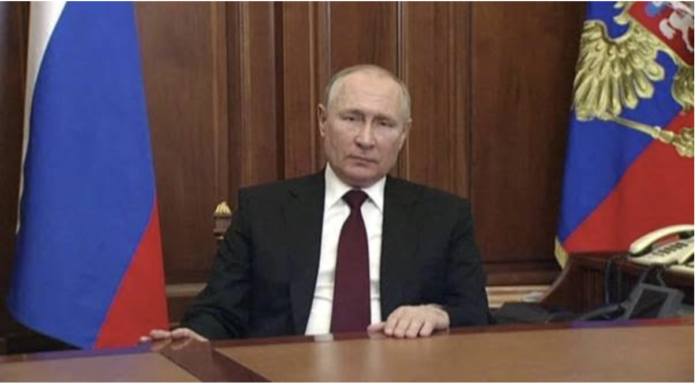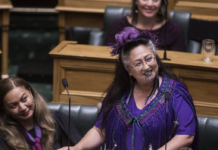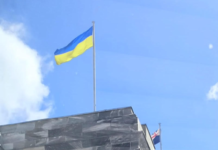The tempo of the ground war in Ukraine has definitely slowed, Russian forces making slow progress in the last 48 hours as we approach another round of negotiations. In the south the area around Enerhodar is in Russian control and the nearby cities of Vasylivka and Orikhiv are currently being contested, indicating a steady advance north along the Dnieper towards Zaporizhzhia, a city of nearly a million people.
On the northern axis Kiev is still under pressure, the Russians massing forces north of the city and trying to envelop the Ukrainian defender’s western flank. Most significantly, fighting is currently reported in Obukhiv, approximately 35 kilometres south of Kiev and close to the Dnieper. The fighting around Obukhiv represents the tip of encircling forces who are also fighting in a number of other areas north and west of this battle, trying to create a ring around Kiev.
This is an important development because it provides information about Russian objectives and a possibly a change in their plans. Initially, it was apparent that the Russian strategy was to ‘shock and awe’ Ukraine into submission. Surgical strikes across the country would knock out the Ukrainian air defence network. Then Russian ground forces swarming across the border in many places were supposed to make it impossible for the defenders to predict where the main blow would fall, forcing them to panic and either retreat or surrender.
The Russian plan did not work, now they have paused, reconstituted as predicted (Article 4 in this series – Putin is in Trouble) and are developing new strategy. Initially, it looked like they would push for Kiev and try to take the city by storm. Events in recent days suggest otherwise. NATO’s refusal to intervene by creating a ‘no fly zone’ is a key factor because takes pressure off the Russians.
Now, Putin has time, he no longer has to worry about finishing the operation before a ‘no fly zone’ takes his powerful air force out of the contest. He can now wait and slowly attrit the Ukrainian air force. NATO’s policy position also removes another high-risk contingency for the Russians, deployment of the NATO Response Force. This is NATO’s rapid response capability, approximately 40,000 of the best soldiers in the world able to move at very short notice. If NATO is not going to institute a ‘no fly zone’ it is definitely not going to commit soldiers either, so Russian planning assumptions can change. A short war is no longer required to avoid NATO intervention.
The key objective remains Kiev and we see a slow but steady tightening of the Russian noose around the city. Now it looks unlikely that Russia will pulverise the city because it needs a quick victory. Instead, they are using the large concentration of force north of the city to menace and fix Ukrainian forces in the city. The forces north of the city provide a firm base for envelopment and we are seeing fighting that confirms this strategy. The Russians are taking time now to slowly encircle and cut the city off and slowly capturing Ukraine’s power generating facilities so their aim is likely to be starving the city into submission.
With NATO intervention ruled out then this is an economic strategy. Russia can take time and slowly build its military power, concentrating on a small number of areas like Kiev in the north and one axis of advance in the south means the invasion force is easier to supply and easier to coordinate, operations can be planned and executed in small, easy steps.
The south provides the most interesting developments, as fighting pushes north along the Dnieper we can see the possibility of two Russian options developing either; continuing to advance slowly north towards Kiev with the Dnieper protecting their west flank or crossing the Dnieper at multiple points and advancing towards Odessa.
The Russians are about 450 kilometres south of Kiev so advancing north along the Dnieper and linking up with the Russian force attacking Kiev is a significant operation. An advance rate of 20-30 kilometres per day is probably a sensible planning figure for an operation like this meaning a commitment of about a month. The logistics are problematic and manpower will be an issue, however if it can be done, then the Russians will encircle the eastern half of Ukraine.
Russian planners will likely be balancing this option against pushing east from Kherson to take Odessa only 140 kilometres away. Based on assessments of Russian strength this seems like a better option, but I think that the choice will be influenced more by political analysis than by military planning.
Essentially, the Russians are still militarily stuck because they do not currently have the forces, they need to conquer Ukraine. NATO’s policy on intervention, whilst preventing escalation, provides Russia with time to develop options. If there was any chance of a NATO ‘no fly zone’ or 40,000 professional well equipped NATO troops entering the battle then the Russians needed a quick victory. A key learning from this war is that the Russian army is in no way trained to fight using modern tactics and German, British, American or other NATO troops, professional and battle hardened in Afghanistan would easily defeat the Russians.
Russia’s, nuclear rhetoric and recent threats to neighbouring countries about allowing the Ukrainians to use their airbases demonstrate how big a threat NATO intervention and airpower is to the Russians. Now, this threat is gone so Russia can start to think about winning the peace. It may not be able to conquer all of Ukraine but Russia can plan slowly and strategically for what it wants from a peace deal. At this stage it is hard to say what these goals are, and we need to watch how the ground battle develops to give us further clues. Generally speaking I think the options are likely to be either; cutting off Ukraine east of the Dnieper and creating a client state, or a creating Crimean Corridor.
So at the end of D + 11 let’s look at our predictions:
- Defining Russian main effort is difficult. Kiev is still a key objective but the situation is stable there and the Russians may seek to advance faster in other less contested areas. These operations will help us to see their longer-term goals.
- At this time the Russians are tending to push north from Kherson with very limited reports of fighting west of the Dnieper. It is too soon to tell yet whether the focus will continue to north or whether they will switch west towards Odessa, but expect Russian intentions to become clearer in the next few days.
- The negotiation table is now the key area of battle. Putin is looking for options, continuing discussions with Macron and opening discussions with the west via Israel. The Russians now have time but still have too little combat power to conquer the country. Putin needs to negotiate if he wants a quick win, because although the Ukrainians cannot defeat him, they certainly have the ability to make the war long and costly. Expect to see some movement both in negotiations and on battlefield as both sides jockey for position.
In summary, we are entering a new phase of the campaign, in recent days NATO’s policy has been confirmed. The Russians do not have to worry about ‘no fly zones’ or other direct intervention. Something that in the last weeks must have been worrying them because of NATO’s united response. Now the Russian have time to re-organise, strategise and prepare for their next move, but they are still over-extended and unable to conquer all of Ukraine. Expect to see negotiations backed by slow steady Russian advances on key cities and on key infra-structure as Russia slowly strangles Ukraine’s major cities forcing concessions out of Ukrainian negotiators.
Ben Morgan is a tired Gen X interested in international politics. He is TDB’s Military analyst.






” A key learning from this war is that …”
That’s P.C. Plod the policeman testifying in court vocabulary. For the rest of us they’re lessons, not learnings.
Yay! I’m so over the dumbing down of our language.
That’s another vote for lessons over learnings.
got my vote
what about
‘the france football team’
as opposed to –
‘the french football team’ or even, the convoluted ‘the football team from france’
are NZ kids deemed to dim to learn ‘modifiers’?
But if NATO forces in Afghanistan were so shit hot , how come they could never win , even after 20 years?
“Winning” was never the objective. Afghanistan was only ever about providing a convenient battlefield within which weapons and troops could be battle tested and trained.
It has struck me that the US seems to have a policy of always having a war going somewhere so that there is always a good number of troops that are accustomed to that environment.
D J S
Interesting thought and if you want a battle experienced military it does make sense.
as is the ukraine ‘aitch’ nato will not save the ukraine just throw on enough small arms to keep the pot boiling…orwells/goldsteins observation that the actual point of continuous war isn’t victory but the destruction of the products of human labour
It’s worth considering that in 1939 the gremans took a month to subdue the polish forces even with their embryonic blitzkreg tactics, poland back then was roughly a similar size as ukraine today. Also there are other parallels in sizes, dispersal of forces, morale- and support from but muted military response of western nations. Ukraine seems to be winning the propaganda war thou and the slow (to modern eyes) russian advance could be a feint to draw out the ukraine millitary before a renewed push forward. It’s also compelling to ponder another possible parallel situation to poland in 1939. What if EU or nato forces themselves ‘invaded’ western Ukraine, you might end up with the exact reverse (east vs west) with the russians attacking during the ’39 polish campaign. If the ukrainian forces facing the EU surrendered on mass to nato, then there would be a cadre force (and on ukraine ground) to reconstitute a ‘free Ukraine’ of course thats a mad gamble for nato… as putin clearly still thinks of Ukraine as a vassal state of Russia- but in few weeks russian forces could be driving up to the border of poland, slovakia, hungary, romania, and eyeballing EU forces anyway and still with Ukrainian insurgents at his rear and forcing him to have a large garrison force almost permanantly in the Ukraine. Unless putin looses his nerve and having achieved ‘some’ goals retires to the negotiation table withdrawing to a now linked donbass region and crimea. But lets hope all comparisons to 1939 end there!
I think the US is hoping that this war in Ukraine will bleed Russia to death.Slay the monster once and for all.
Destroying Ukraine and inflicting further death on its innocent civilians is just unavoidable collateral.I very much think Zelensky is now safely in The US Embassy in Poland.Mainly to prevent him from coming to any ceasefire or peace agreement with the Russians .He’s got a gun at his head from both sides, the CIA and the far right armed militia on the other .Dmitry Yarosh, ex commander of Right Sector is now chief adviser to Ukraine’s defense ministry.
Ben, it doesn’t seem like ‘shock and awe’ at all. Where are the aerial bombings of civilian areas ala Belgrade?
This assertion and “the need for a quick victory” seems like a misreading of your foe’s tactics and war aims.
The reports coming from Kiev of Russian troops shelling the humanitarian corridors in Mariupol does not make sense.Why do you think the Russians haven’t Groznyed or Raqqaed, or Tokyoed Mariupol? Because Mariupol is in the Donbas (basin of the Don river), where many ethnic Russians live.If they didnt care about those lives they’d go all in , like the US did in Raqqa , or Baghdad
The Azov Battallion has its headquarters in this city , could they be preventing civilians from leaving , thus keeping them as hostages, knowing the Russians will be hampered by the presence of civilians
yes agree . Tactics adopted from Syrian “moderates ” , and doesn’t that make them the equivalent of isis , hamas and all those other U.S foes who shelter amongst civilians? And actually doesn’t that apply to all Ukrainian forces sheltering amongst civilians?
Us righteous folk in the west should condemn this outrageous cowardice.
Ukraine isn’t a member of NATO hence no NATO. Besides NATO is a “defensive alliance” guaranteeing security for its members and their interests , yunno , like oil markets in Iraqi , heroin markets in afghanistan and slave markets in Libya . Yay NATO
*Breaking*
Daniel Faitaua of TVNZ just reported that the people of Ukraine are now drinking out of puddles, which is a perfect analogy for the West’s gutter journalism we are being forced to consume.
yesss but they’re OUR NAZIS…..